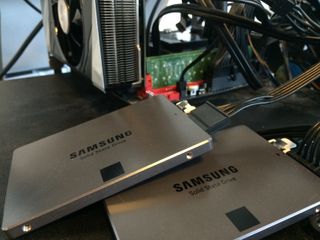It is not surprising that Microsoft has lowered support for software RAID, as since Windows 8 it has incorporated a more advanced RAID technology that is called Storage Spaces. Microsoft always phases-out older technology in favor of newer one. If you really want the classic RAID, you'll need the Pro or Enterprise editions of Windows 10. Do not mix hardware RAID 0 with software RAID 0. A striped volume cannot hold the system or boot partition of a Windows Server 2003-based system. You cannot extend or mirror striped volumes. There is no fault tolerance on a striped volume. This means that if one of the disks becomes damaged or no longer functions properly, the whole volume is lost. For Software RAID 0 in Windows define the 2 SSD's as a storage pool with no redundancy and use the total pool as a storage volume. This is effectively Software RAID but Windows doesn't call it that. As far as hardware RAID cards are concerned - consumer grade RAID cards are usually HIDEOUS - you are better off using Software RAID (in Linux run.

Mar 27, 2015 RAID 0 is the easiest way to get more speed out of two or more drives, and lets you use a pretty cool acronym to boot. In our test rig, we used a pair of Samsung 840EVOs with the latest firmware. Any suggestions for which would give the best performance? I've always understood that Windows software RAID was pretty poor (although probably better than non-striped) but that was compared to hardware RAID. Can't find much which compares software RAID to storage spaces. A straight-through video tutorial on how to configure and setup Software RAID on Windows. Note that while this is on Windows 7, the control panel has not changed on Windows 8 or 10 (pro only) so. I use to have RAID-0 setup when I had Windows 7 installed. I wiped out my entire machine and did a fresh install of Windows 10. I have 4 1TB matching drives. Used for all OS and software. Used for all personal data. Want to use for RAID-0 for #1. Want to use for RAID-0 for #2.
Looking to squeeze a bit more speed out of my development PC for test VMs without necessarily switching to hardware RAID. I've got two identical 2TB SATA-3 data drives (OS is on SSD) so I could rebuild as a Windows 10 striped disk (using disk manager) or create a Windows 10 storage pool with a simple space.
Any suggestions for which would give the best performance? I've always understood that Windows software RAID was pretty poor (although probably better than non-striped) but that was compared to hardware RAID. Can't find much which compares software RAID to storage spaces.
munrobashermunrobasher1 Answer
Performance of single HDD
- this is just our base performance of single drive
Striped dynamic disk over 3 HDDs
- this what you call Windows software RAID
3-column simple Storage Space over the same 3 HDDs

- this is adhoc storage space I made for you with
$spaceDisk = New-VirtualDisk -FriendlyName $spaceName -StoragePoolFriendlyName $poolName -NumberOfColumns 3 -NumberOfDataCopies 1 -ResiliencySettingName Simple -ProvisioningType Thin -Size $spaceSize - the
-NumberOfColumns 3controls the performance
In both test I used three 3 TB Toshiba HDDs (DT01ACA300). The Storage Spaces have bad reputation when it comes to performance, but that is mainly because of really poor performance of parity Storage Space. Striping looks fine as you see.
Windows Software Raid 0 Windows 10
Note that this is very bad benchmark, it is obvious that Windows cache kicked in for sequential read as there is no way that the 3 disks would attain 1100 MB/s for read. But you can take this numbers and compare them directly to this album.
 Vlastimil OvčáčíkVlastimil Ovčáčík
Vlastimil OvčáčíkVlastimil Ovčáčík